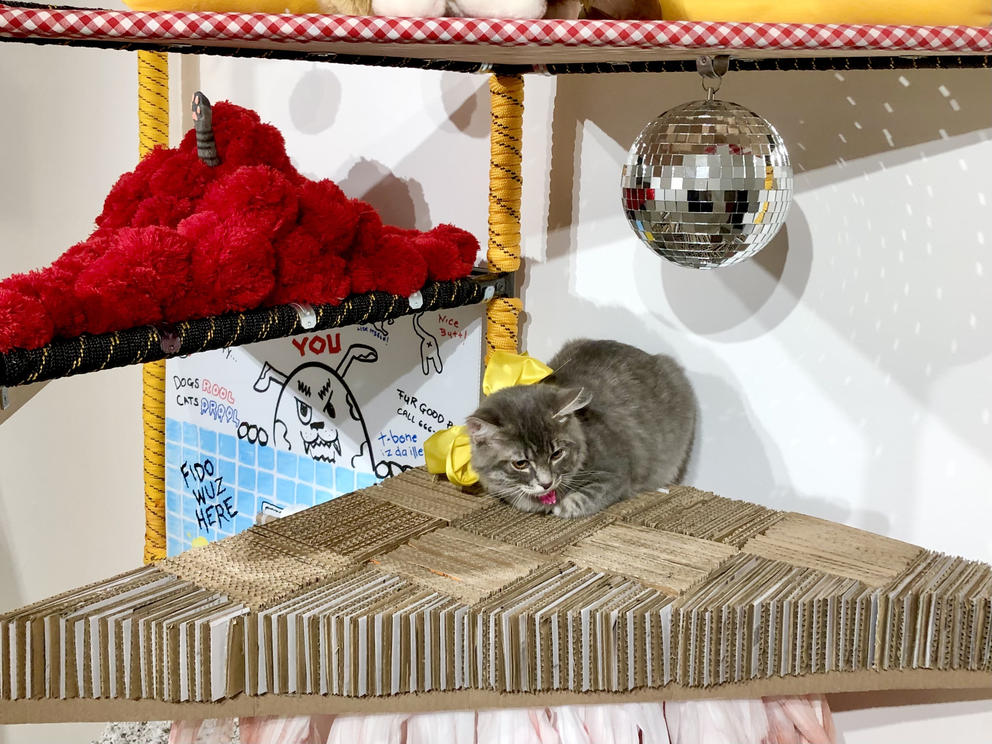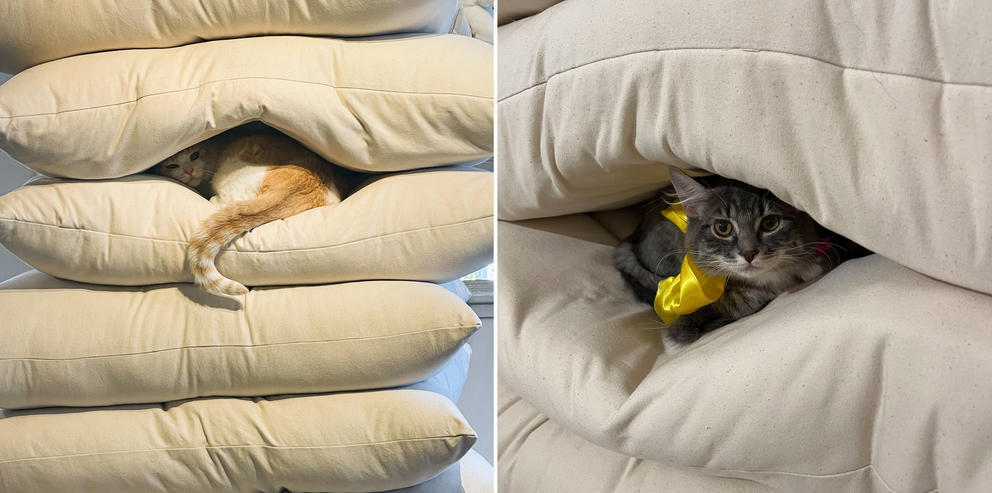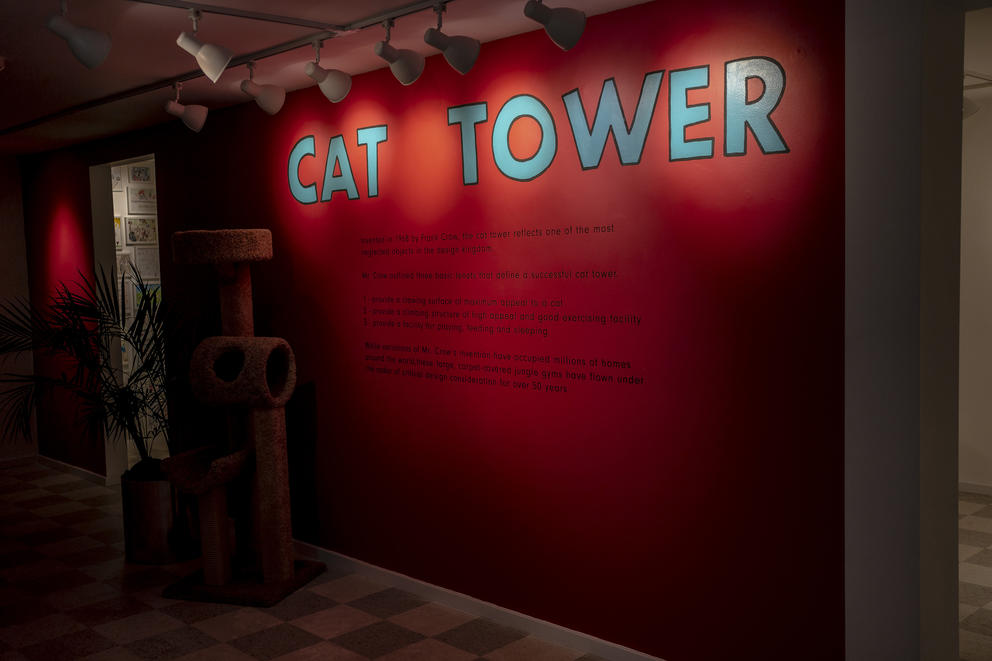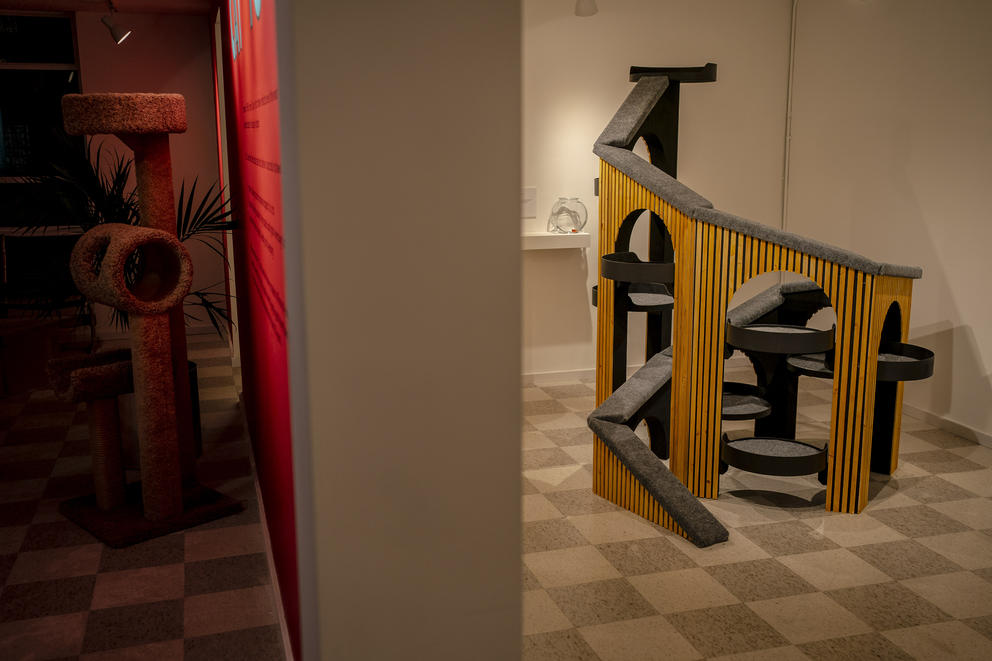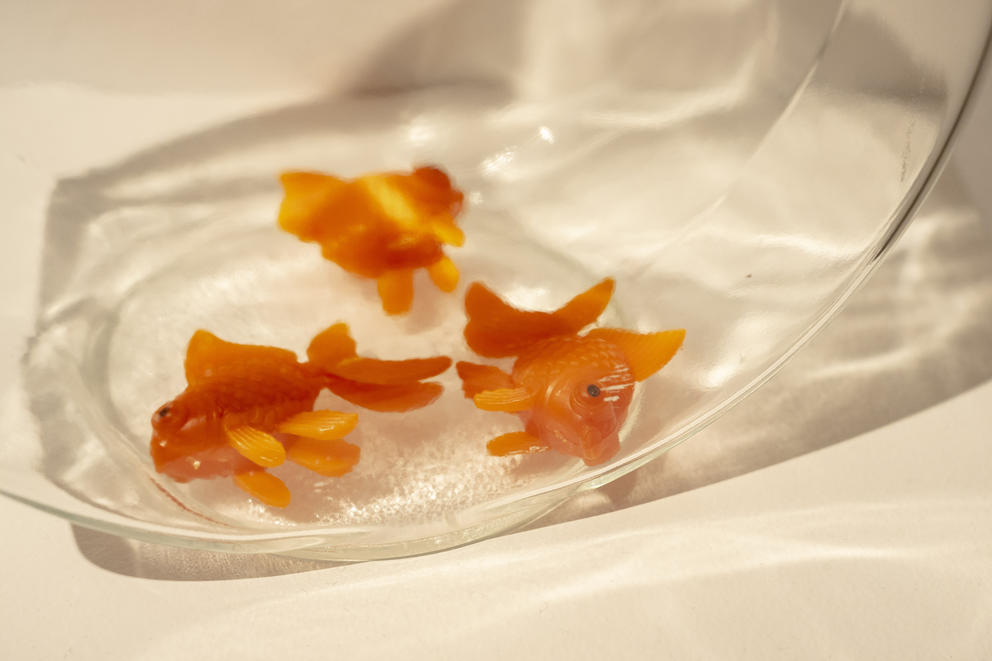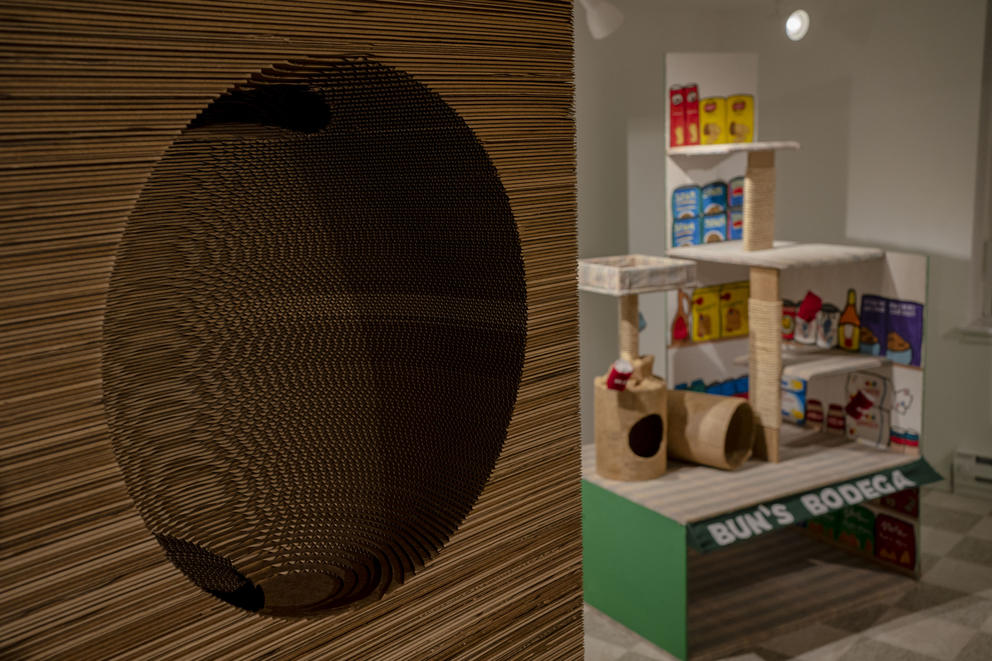Khione is an adventurous, slender Snow Bengal, Oliver a goodhearted marmalade cat and Luna a timid white-and-orange tabby; they were all at the Museum of Museums on Capitol Hill to check out the show, Cat Tower! (through May 1). On view: a dozen creative takes on cat treehouses designed by local artists, architects and designers. Social cats are welcome to test-drive them every Wednesday and Sunday.
“Today is kinda crazy because people are bringing in their cats,” a front-desk staffer warns a duo that has just walked in, sans cat. But even two-footed mammals can find something to enjoy in this varied show.
Just as in a people-facing group show, the 12 creative cat towers (each fully functional for felines), run the artistic gamut: There’s the witty (Andrea Chen’s Bodega-inspired structure, featuring plush soda cans and foam shelves); the ultra-modern (Casual Surveying Co.’s walnut bookcase-cum-cat hammock); and the extravagant (an homage to indie rock queen Chan Marshall, aka Cat Power, with disco ball and pink yarn).
For cats with an appreciation of art history, there’s the surrealist (a colorful, nine-level Dante’s Disco Inferno assemblage by Design Nerds, representing the “tempestuous journey a feline must reckon with on their way towards the dance floor”) and the conceptual (a 2001: A Space Odyssey-inspired MEOWolith column made from stacked, laser-cut cardboard by local architecture-design studio SHED).
“We joked on our team that if we wanted to really make a good cat tower, we'd just upturn a few Amazon boxes or paper bags. Cats love them and they are everywhere!” says Prentis Hale, one member of the seven-person team at SHED who worked on the design. SHED has a track record of sculptural projects (including large-scale installations at art shows), but it has never designed a cat tower before. The Amazon boxes remained on the cutting room floor, as did a “Cat Rack” (which doubled as a coat rack) and “Cat Bag” (“Why reinvent the bag?” reads a sketch of a cat in a paper bag).
A cat named Marigold contemplates its nine lives on this artsy cat tower called "Dante's Disco Inferno," created by Seattle Design Nerds. The work is part of a new exhibit at the Museum of Museums, titled ‘CAT TOWER!’ Visitors are allowed to bring their own cats to play on the interactive exhibits. (Timothy Rysdyke/Museum of Museums)
In the end, the MEOWolith looks more like a literal tower — an imposing, slightly menacing 6-foot-tall rectangle of layered laser-cut cardboard, with planetary holes (seemingly made by a giant ice cream scooper) for cats to retreat into.
“We had a number of ‘stacking’ ideas, and as it evolved into a carved-out tower someone coined the term MEOWolith after the monolith of 2001.” Hale says. “Then the piece really came together as a mysterious first totem of the cat kingdoms throughout the universe.”
Besides laser-cutting, there was some other cutting-edge engineering involved: “We did have one very funny day where we started measuring cats at home — working remotely — and posting the image of a cat being measured up to make sure cats could navigate our tower,” Hale says.
As the welcoming exhibit wall text announces, the designer (or patent holder) of the first “cat tree,” in 1969, Frank Crow, posited that in order to be successful, a cat tower needed to merely fulfill cats’ need for clawing, climbing, feeding, playing and, of course, sleeping. Plus, we might add: it should provide a high perch with a clear view of the cat’s territory (our living rooms) and the subjects they lord over (us). For decades, the ubiquitous beige carpet-covered cat tower Ur-model and its aesthetic siblings were a bitter pill that design-conscious cat lovers had to swallow in the name of feline comfort.
Cats (left: Luna, Right: Marigold) burrow into a tower of pillows, designed by the renowned architecture firm Olson Kundig. The design is part of the ‘CAT TOWER!’ exhibit at Museum of Museums. Visitors are allowed to bring their own cats to play on the interactive exhibits. Left: (Margo Vansynghel/Crosscut) Right: (Timothy Rysdyke/Museum of Museums)
MoM’s artist-designed towers provide something different — but will cats, famous for their disdain, bite?
Khione, the Snow Bengal named after the three-headed Greek goddess of snow, doesn’t need much nudging and immediately jumps onto “Kittie Babel,” by Seattle artist W. Scott Trimble. Its wood-slatted arches give way to round platforms covered in gray carpet, forming a sort of Great Wall cats can use to head to the top. Khione spryly ascends the thin trestle, pausing for some sniffs along the way — an instinctive balancing act.
The iconic story of the Tower of Babel — and its theme of disrupted unity — seemed like the perfect fit for a cat tower, Trimble says. “I see cats as very independently minded, and they may be the metaphorical depiction of the human disruption to building the tower,” he says.
A glance at the artist’s statement on the wall plaque doesn’t reveal any references to this slightly heady subject matter. Trimble simply writes: “Our cats growing up were gopher killers and prided themselves on their latest endeavors by sharing the remnants with us on the front porch. If we had a cat tower it probably would have [borne] the brunt of heavy stain cleaner.” It’s a welcome reprieve from opaque art-speak full of “intersections,” “paradigms” and “dichotomies” of difficult-to-grasp concepts one often finds at art museums and galleries.
Meanwhile, Khione’s guardian is helping her up onto another installation, an understated leather hammock by local design studio fruitsuper. She immediately jumps off, dropping 6 feet with ease. Most likely not a snub of the design, but more of a personality type: Khione appreciates the big and bold.
When she walks up to “Mihraaaaanda,” by local artist Maija Fiebig, it’s kismet. Khione paws at the colorful pompoms and hops all the way to the penultimate platform, topped by a yarn-covered blue cat head (and more pompoms).
“I've never thought of building a cat tower as I don't even like cats,” Fiebig, who makes colorful, abstract paintings, tells me in an email. “But this was a great excuse to try out some of the ideas I originally had intended for [human] furniture and three-dimensional objects.” With MoM’s call for cat tower proposals in mind, when the most recent snowstorm hit Seattle, Fiebig got to work with what she had lying around: cardboard, a glue gun and tons of jute and yarn. “You can pretty much build anything with cardboard and hot glue,” she says.
Asked whether she had an ideal cat in mind for her tower, Fiebig said: “I was hoping this tower would only attract geriatric cats, as I'm slightly attached to the 200-plus hours of weaving I put into it! But I also love the idea of art being destroyed, especially by cats. A little lesson in attachment, I suppose.”
Speaking of attachment, back at MoM, Luna, the timid tabby, has a little bit of a harder time acclimating. Slightly shaking, she burrows into her guardian Angelica Rios’ arms after Rios carefully walks Luna out of the “comedown room,” as Rios puts it.
She carries Luna past “The Most Important Zoom Call of Your Life,” a clever art piece by local artist and filmmaker Clyde Petersen, consisting of a laptop on a tall table next to a glass of water and a half-finished puzzle. Luna shows zero interest. Has she sniffed it out as a nonfunctioning laptop? Or maybe this one is channeling human desires. As Petersen writes in the wall text, “Don’t we all want to pour a little water on our laptops from time to time…?” Amen.
Luna finds her happy place elsewhere: in the “Plush Palace” designed by the internationally renowned, Seattle-based architecture company Olson Kundig (which also designed the Burke Museum on the University of Washington Campus and the LeBron James Innovation Center at the Nike headquarters). Drawing inspiration from the traditional fable “The Princess and the Pea,” the cat tower here is a stack of 12 extra-large pillows. The inside of the edifice is hollow, to facilitate burrowing and climbing; the cats can access it through a few spaces in between the pillows. Rios gently places Luna into one of the soft openings.
“It’s a hit,” she concludes.
“It’s going to be hard to get her out of there,” says Rios' friend, Danny Jemtegaard. “She’s burying her head like a llama.”
After Luna comfortably curls up and an impromptu Instagram shoot ensues, the couple is ready to move on. But Luna remains unmovable. Rios and Jemtegaard debate extraction strategies. Give her a push in? Or grab her from the other side through one of the holes? As they try pulling, Luna sinks in her claws — she’s found a good spot, and she is not letting go.
If Luna and Khione are any indication, cats seem drawn to the scent trail of the towers that fit their personality. For the good-natured Oliver, whose pink-haired owner wheels him around in a bubblegum-pink buggy that matches his pink collar, that means a perch is a perch.
At home, his guardian, Hutton Sutherland, explains, Oliver has an impressive setup for climbing, scratching and parkour tricks. But it doesn’t seem to have made him a cat tower snob. When he gets lifted up onto an installation, he happily finds a spot to plop down and survey the room: the MEOWolith (check). Kittie Babel (check). Bun’s Bodega (check).
But, like a true iconoclast, Oliver also seems to appreciate what was not intended to be an artwork. He looks particularly cozy as he curls up on a sun-drenched windowsill at MoM, or when he snuggles into the one nonartist-created tower present: the store-bought brown rug-covered model installed in the front gallery as an introduction to the concept. Ceci n’est pas une artful cat tower, but Oliver does not care. “He loves this one,” Sutherland says, laughing. “He’s not going to come out – he loves it so much.”
Get the latest in local arts and culture
This weekly newsletter brings arts news and cultural events straight to your inbox.


